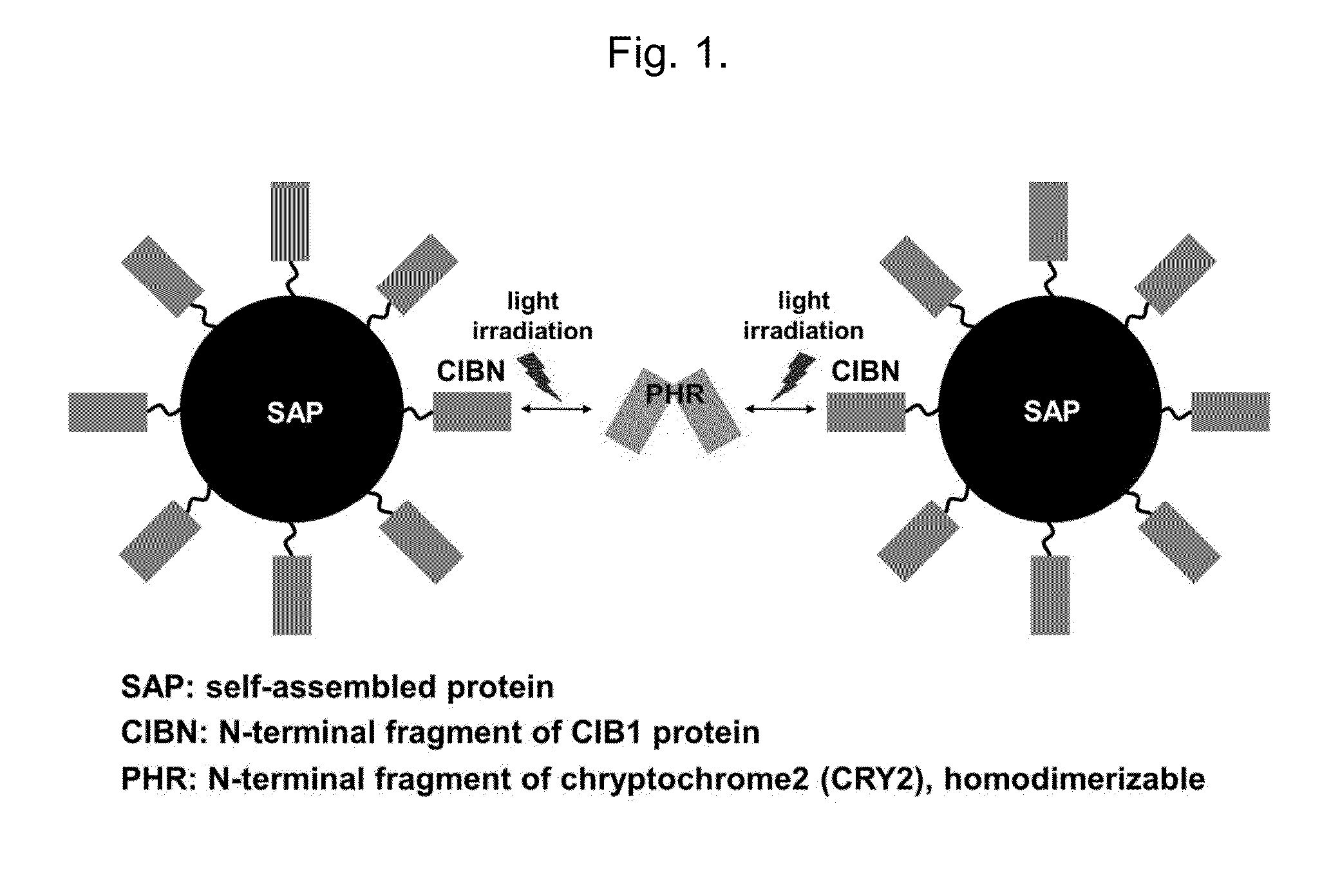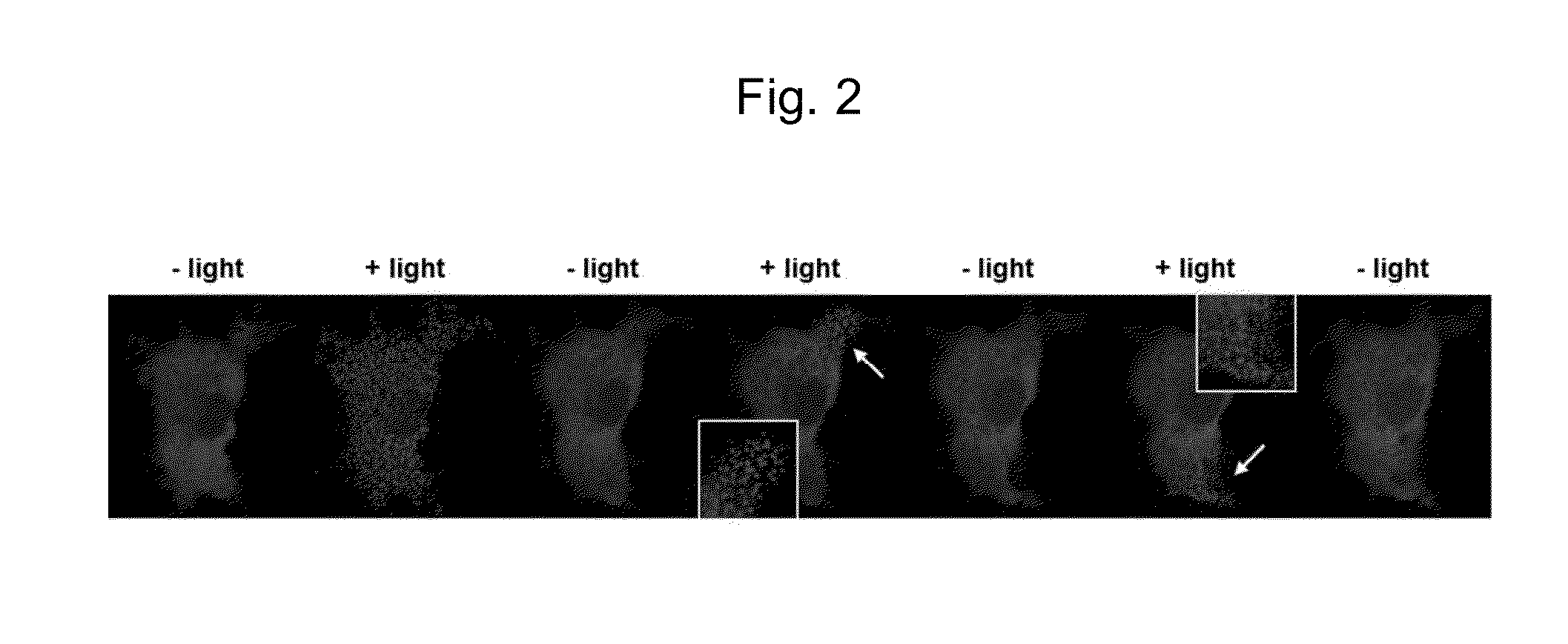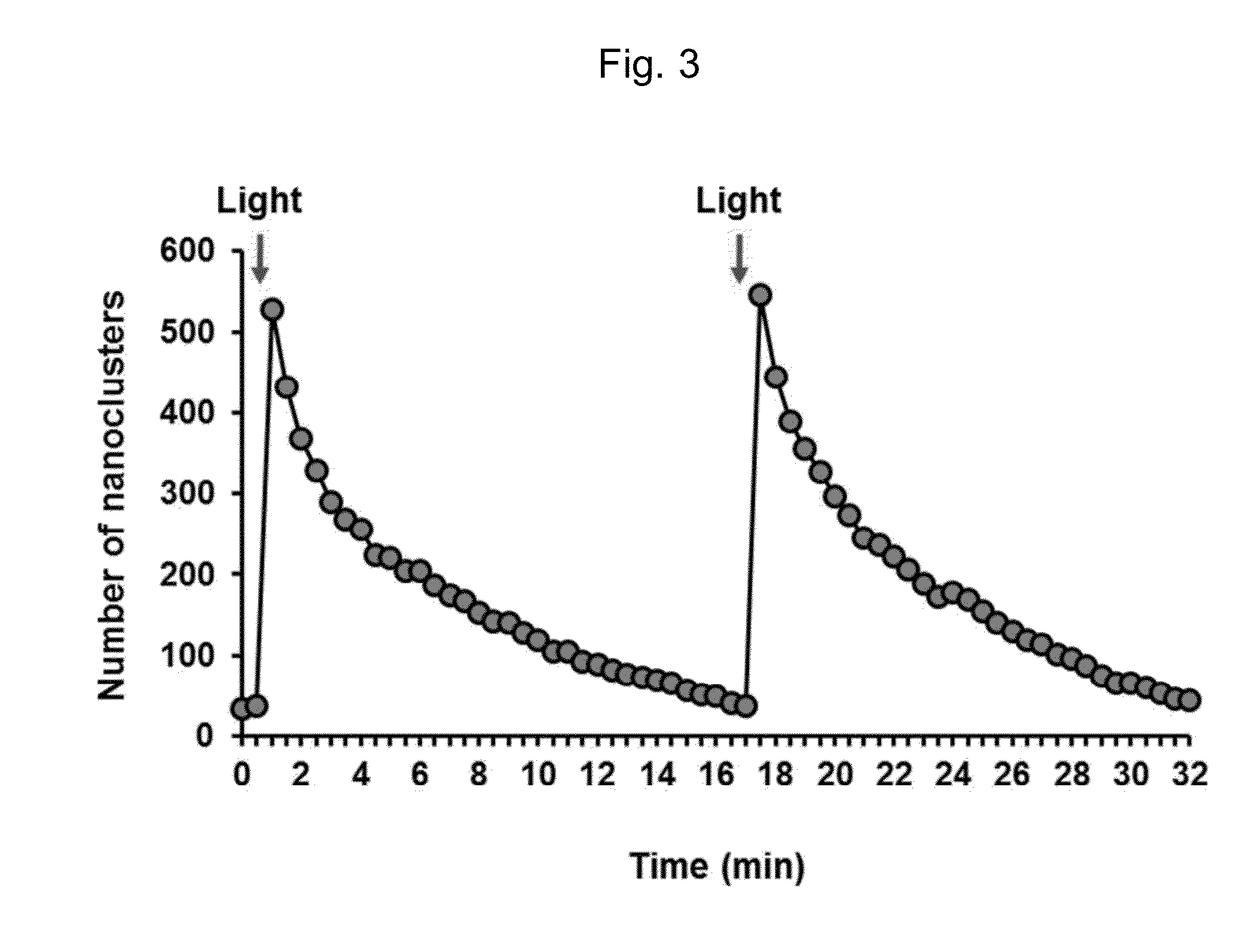Method for forming a reversible protein nanocluster using light in a cell
a technology of reversible proteins and nanoclusters, applied in the field of forming a reversible protein nanocluster, can solve problems such as hard to convince experimentalists
- Summary
- Abstract
- Description
- Claims
- Application Information
AI Technical Summary
Benefits of technology
Problems solved by technology
Method used
Image
Examples
example 1
Construction of Vectors
1-1: Preparation of CIBN-CFP-AD constructs
[0273]The present inventors constructed a polynucleotide encoding a fusion protein in which CFP (cyan fluorescent protein) and an N-terminal (1-170 a.a.) of CIB1 (cryptochrome-interacting basic-helix-loop-helix, GenBank No.: NM—119618) is serially fused to N-terminal of AD (315-478 a.a.) of CaMKIIα (GenBank No.: NM—012920) involving in self-assembly of the CaMIIα, and thus constructed resulting a CIBN-CFP-AD construct by inserting the polynucleotide into a pCFP-C1 vector replacing a polynucleotide encoding CFP of the vector with the polynucleotide encoding the fusion protein (FIG. 1.).
1-2: Preparation of PHRCRY2-mCherry Construct
[0274]A polynucleotide encoding a polypeptide fragment (1-498 a.a.) corresponding PHR (phytolyase homologous region) domain of CYR2 protein (GenBank No. NM—100320) was inserted into pmCherry-N1 vector (Clontech, USA) and the resulting PHRCRY2-mCherry construct was prepared thereby. The CRY prot...
example 2
Preparation of Vectors for Analyzing Protein Interaction
[0275]The present inventors constructed expression vectors capable of expressing a bait protein and a target protein as described below, in order to investigate whether the method for analyzing protein interaction using the light-induced nanocluster formation may be used for analyzing the interaction between other proteins based on the result of example 1.
2-1: Preparation of PHR-CCF)-Hras(Active) Construct
[0276]The present inventors constructed PHR-ECFP-Hras(active) construct by producing a polynucleotide encoding a fusion protein in which the PHR domain (1-498 a.a.) of CRY2 (GenBank No.: NM—100320) and a bait protein, active form Hras (GenBank No.: NM—001130442.1, Q61L mutant, CAAX-deleted) are fused to N-terminal and C-terminal of ECFP, respectively and inserting the polynucleotide into pECFP-C1 vector (Clontech, USA).
2-2: Preparation of YFP-RBDraf1 Construct
[0277]The present inventors constructed YFP-RBDraf1 construct by ins...
example 3
Construction of Vectors for Inhibiting a Protein Reversibly
3-1: Preparation of CIBN-mCerulean-AD Construct
[0282]CIBN-mCerulearn-AD construct was constructed by inserting a polynucleotide encoding a fusion protein in which a cyan fluorescent protein (mCerulean) and an N-terminal (1-170 a.a.) of CIB1 protein participating in light-induced heterodimerizing are serially fused to the N-terminal of activation domain (315-478 a.a.) into pmCerulean-C1 vector (Clontech, USA) instead of the polynucleotide encoding the mCerulean.
3-2: Preparation of mCitrine-PHRCRY2 Construct
[0283]mCitrine-PHRCRY2 construct was constructed by inserting a polynucleotide encoding a polypeptide corresponding to the PHR of CYR2 protein (1-498 a.a. of CRY2) into pmCitrine-C1 vector (Clontech, USA).
3-3: Preparation of mCitrine-PHRCRY2-Rit tail construct
[0284]mCitrine-PHRCYR2-Rit tail construct was constructed by inserting a polynucleotide encoding a tail domain (193-219 a.a.) of Rit (GenBank No.: NM—006912) which is ...
PUM
| Property | Measurement | Unit |
|---|---|---|
| Wavelength | aaaaa | aaaaa |
| Fluorescence | aaaaa | aaaaa |
| Yellowness index | aaaaa | aaaaa |
Abstract
Description
Claims
Application Information
 Login to View More
Login to View More - R&D
- Intellectual Property
- Life Sciences
- Materials
- Tech Scout
- Unparalleled Data Quality
- Higher Quality Content
- 60% Fewer Hallucinations
Browse by: Latest US Patents, China's latest patents, Technical Efficacy Thesaurus, Application Domain, Technology Topic, Popular Technical Reports.
© 2025 PatSnap. All rights reserved.Legal|Privacy policy|Modern Slavery Act Transparency Statement|Sitemap|About US| Contact US: help@patsnap.com



